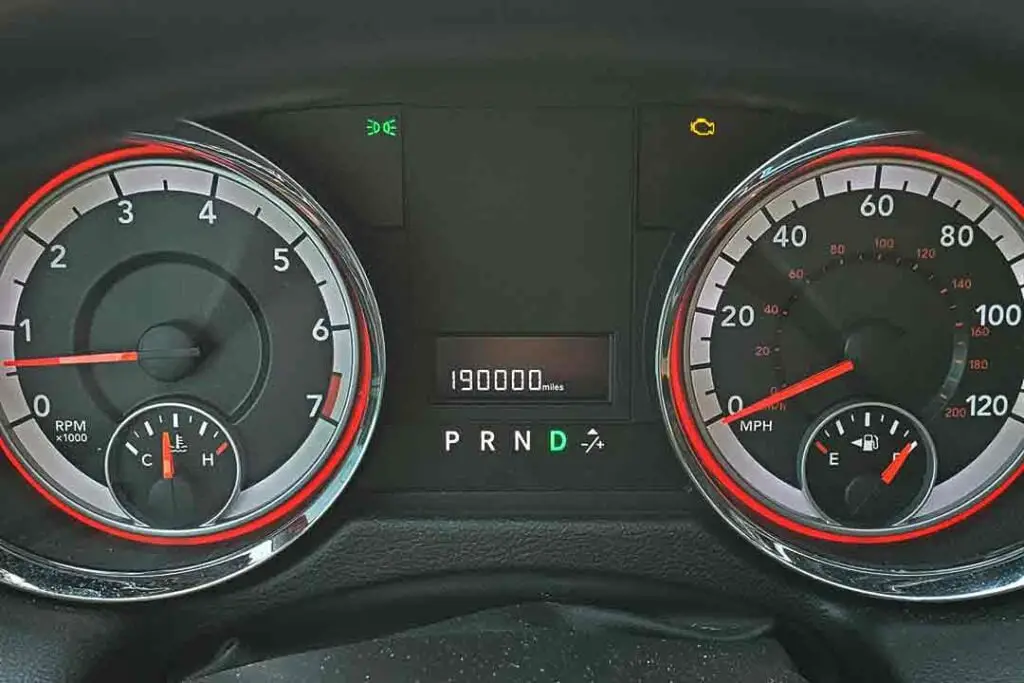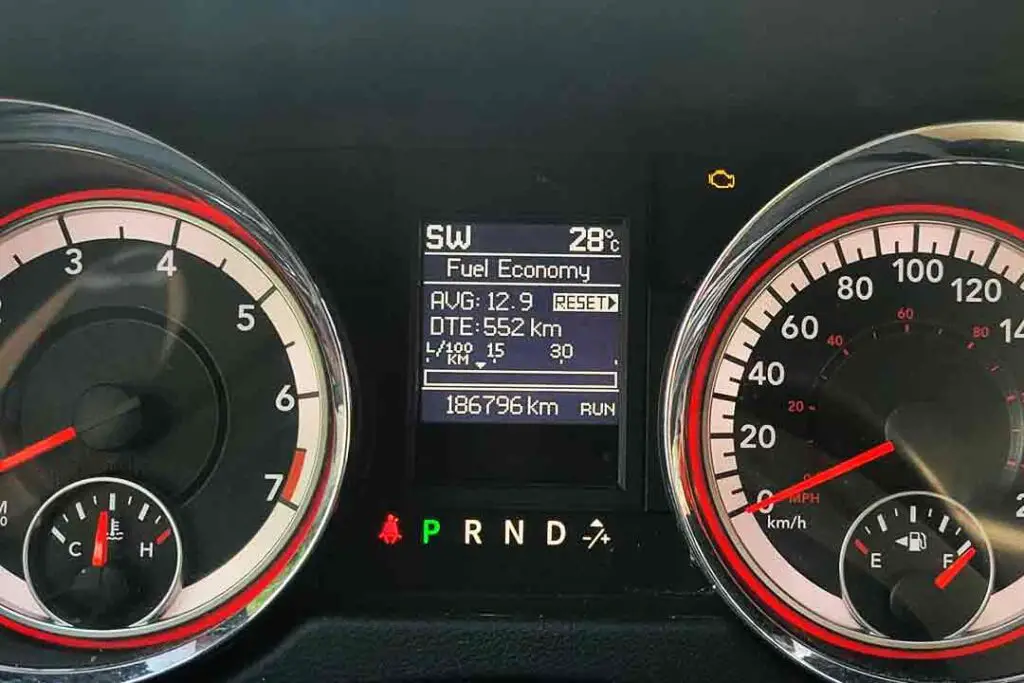The check engine light is essential to any vehicle, including Dodge cars. It serves as a warning sign that an issue with your vehicle may require attention. If you own a Dodge and notice that your Dodge check engine light flashes 10 times, it could indicate a more severe problem. The most common reasons behind this issue are engine misfire, ongoing diagnostic cycle, emission system readiness, any major fault detected, or recent maintenance.

In this article, I will discuss why your Dodge check engine light may be flashing 10 times and the steps to troubleshoot and resolve the issue. Let’s jump into the details.
Contents
What Is the Check Engine Light?
The Check Engine Light (CEL) is a vehicle dashboard warning indicator that signals potential engine or emissions system issues. When illuminated, it alerts the driver that the ECM has found a problem. The CEL can either stay steady or flash, with flashing indicating a more severe issue that requires immediate attention.
While the Check Engine Light provides a valuable warning, it doesn’t pinpoint the exact problem. A mechanic or a DIY enthusiast can use an OBD-II scanner to diagnose the issue and retrieve specific trouble codes from the ECM. These codes provide insights into the problem area, such as engine misfires, sensor malfunctions, or emissions-related faults. Promptly addressing the Check Engine Light can prevent more extensive and costly repairs in the future, making it an essential part of vehicle maintenance.
Reasons Behind Dodge Check Engine Light Flashing 10 Times:
There are several potential reasons why your Dodge check engine light may be flashing 10 times. Some of the most common causes include:
Engine Misfire Detection
One of the most common reasons for the Check Engine Light to flash 10 times is the detection of engine misfires. When the Engine Control Module (ECM) detects a severe and potentially damaging misfire, it initiates the flashing CEL to alert the driver to the issue.
Ongoing Diagnostic Cycle
The flashing Check Engine Light may occur when the ignition is turned to the “On” position (without starting the engine) as part of the vehicle’s onboard diagnostics (OBD-II) system’s self-check process. During this cycle, the ECM runs various tests to ensure all engine systems function correctly. The CEL should stop flashing if no faults are detected during this self-check.
Emission System Readiness
The Check Engine Light flashing 10 times can also indicate that the vehicle’s emission control systems are not yet ready for emissions testing. These readiness monitors include various sensors and components that must go through specific drive cycles to ensure they function correctly. Until all readiness monitors are in the “ready” state, the CEL may continue to flash.
Major Faults Detected
In some cases, the flashing Check Engine Light might indicate the detection of a significant fault that could lead to engine damage or increased emissions. This could include issues with critical systems such as the ignition, fuel delivery, or exhaust components.
Recent Maintenance
If the vehicle’s battery has been recently disconnected or certain maintenance procedures, such as clearing trouble codes, have been performed, the ECM may not have completed its diagnostic cycles. In such cases, the Check Engine Light can flash until the diagnostics are finished.

How Do You Fix the Dodge Check Engine Light Flashes 10 Times Issue?
If your Dodge check engine light is flashing 10 times, here are some steps you can take to address the issue:
1. Investigate Engine Misfire
If you notice a flashing Check Engine Light, it may indicate an engine misfire, resulting in rough idling, reduced power, and poor fuel efficiency. To troubleshoot this issue, use an OBD-II scanner to pinpoint the specific cylinder experiencing the misfire, typically indicated by a diagnostic trouble code (DTC) such as P0301 for cylinder 1.
Then, make sure that the gap settings are correct while inspecting the spark plug for indications of corrosion or fouling, and replace them as necessary.
Also, test the ignition coils and wires for any damages, and if you find any issues, replace the damaged components.
2. Check the Fuel System
Fuel system issues can manifest as poor vehicle performance, decreased fuel efficiency, and results in the check engine light flashing 10 times. To troubleshoot, start by inspecting your fuel filter for any clogs or obstructions and replacing it if necessary to maintain a consistent fuel flow to the engine.
It’s crucial to confirm that the fuel pump is functioning correctly, as any issues with the pump can disrupt the fuel supply.
Next, carefully examine your fuel injectors for potential clogs or leaks, promptly addressing these issues by cleaning or replacing the injectors as required. Also, verify that the fuel pressure falls within the manufacturer’s specifications, as low or erratic fuel pressure can negatively impact performance.
3. Inspect the Catalytic Converter Problem
Catalytic converter problems can lead to increased emissions and reduced engine power, and as a result, you can notice a check engine light flashing on your dashboard. To troubleshoot, use an OBD-II scanner to scan for diagnostic trouble codes (DTCs) associated with the catalytic converter, such as the P0420 code.
Inspect the catalytic converter for any physical damage or blockages and replace it if necessary to restore its proper function.
Remember that it’s crucial to address engine misfires promptly, as they can damage the catalytic converter over time.
4. Replace Faulty Oxygen Sensor
Faulty oxygen sensors can result in poor fuel control and increased emissions, which causes check engine light warning. Use an OBD-II scanner to identify any codes related to oxygen sensors, such as the P0130 code. Once identified, replace any malfunctioning oxygen sensors, typically located within the exhaust system.
5. Clean or Replace Faulty EGR Valve
Issues with the Exhaust Gas Recirculation (EGR) valve can negatively affect engine performance. Use an OBD-II scanner to scan for codes associated with the EGR system, such as the P0401 code. Then check the EGR valve for any obstructions or issues, clean it if necessary, or replace it if you find it faulty.
If necessary, address carbon buildup in the EGR system by cleaning the EGR passages. To prevent EGR valve problems, incorporate regular cleaning of the EGR valve and passages into your routine maintenance.
Read More:
- Can a Bad Hydroboost Affect Steering? [Explained]
- 3 Common 3.9 Dodge Engine Problems You Need to Know About [Fixed]
Conclusion
Never overlook your Dodge’s blinking check engine light since it might be a sign of a major problem. It’s essential to identify the cause of the flashing light and address the issue as soon as possible to prevent further damage to your vehicle and ensure its safety and performance.
Potential causes of a flashing check engine light in a Dodge include engine misfire, fuel system problems, catalytic converter issues, EGR valve problems, and oxygen sensor malfunctions. Follow the troubleshooting as mentioned above; if you are not a DIY enthusiast, I recommend consulting a certified Dodge mechanic or Dodge dealership to repair this issue perfectly. If you have any further queries, please feel free to comment below!

what does it mean if the cel only flashes in the on the position, 10 times, then stops, but wont turn on.
If the Check Engine Light (CEL) flashes 10 times when the ignition is turned on but doesn’t stay on, it likely indicates a detected issue during the self-check. The 10 flashes may correspond to a specific trouble code. Use an OBD-II scanner to retrieve codes for more details. If you are unable to retrieve codes or if the problem persists, consult a mechanic for proper diagnosis and repairs.